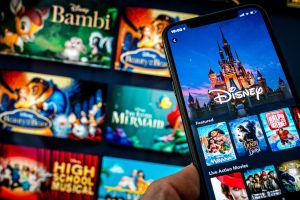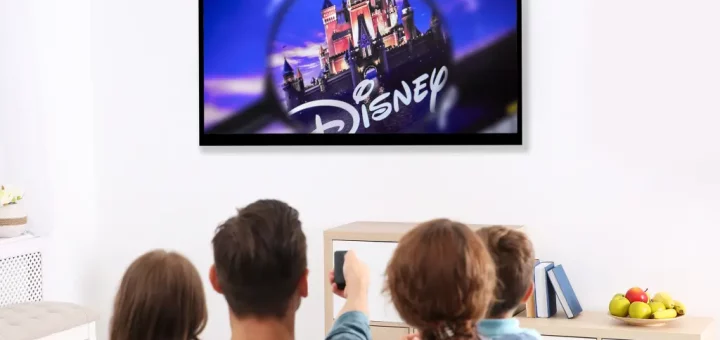Bob Iger’s Streaming Strategy Will Take Disney Back to the Future
Bob Iger just spoke as a featured guest during the Morgan Stanley Technology, Media and Telecom Conference.
As part of his comments, Iger addressed the dancing pink elephant in the living room.


Photo: Getty Images
Media streaming strategies haven’t gone as well as hoped.
At the start of the pandemic, all streaming services entered a boom phase as the rising tide lifted all boats.


Photo:cnet.com
Now that everyone can go back outside again, the bubble has burst. How does Disney plan to account for this dramatic reset?
Bob Iger’s streaming strategy will take us back to the future. Allow me to explain what’s happening behind the scenes in the corporate media world.
Bob Iger’s 2016 Problem


Photo by Chip Somodevilla/Getty Images
During Bob Iger’s first tenure as CEO of The Walt Disney Company, he famously experienced an epiphany.
Iger had licensed the rights to many Disney movies to Netflix, the dominant streaming service of the past 15 years.


Photo: Netflix
One day, Iger suddenly realized he was “selling nukes to the enemy” by enabling Disney content on Netflix.
In that moment, Iger almost unintentionally invented Disney+, as he strategized a new future.


Source: comicbook.com
At the time, virtually everyone recognized that linear television had lost its grip on an entire generation of would-be viewers.
As the so-called Second Screen children matured, their viewing habits worked differently than anyone in nearly a century.


Photo: Forbes
People over 35 grew up in a world where television was the dominant means of media consumption. The smartphone and tablet generation behaved differently.
These people never paid cable bills and had no interest in starting once they moved out on their own.


(AP Photo/Matt Dunham, file)
For cable merchants, Gen Z represents an extinction-level event, just as the newspaper industry faced due to the rise of online publications a decade before that.
Iger constantly stressed about this fact, as Disney earned a sizable amount of revenue from its linear television divisions.


Photo: Wikimedia
Disney’s spreadsheet wouldn’t look good if it lost advertising revenue and carriage fees from Disney Channel, ABC, and especially ESPN.
Did you know cable companies paid ESPN $7.21 per customer for carriage rights in 2016? And 90 million people had access to ESPN!


Folks, that’s nearly $650 million in revenue for that one part of Disney’s media empire…and I’m not even including ad revenue, only carriage fees!
Even worse, Disney used its media empire as a brand-building machine.


Photo: skillastics.com
Fewer eyeballs would lead to lower merchandise sales and theme park revenue, too!
Bob Iger faced a corporate existential crisis due to the rise of streaming.
Bob Iger’s 2016 Plan


Photo: Washington Post illustration; Jordan Strauss/Invision/AP; iStock
Ever the proactive visionary, Iger embarked on a plan. He envisioned a future wherein Disney reinvented its linear television business via streaming.
Due to his epiphany, Iger decided that he would clean up one of Disney’s weaknesses by transitioning to a streaming model.


(Photo by Kimberly White/Getty Images for Vanity Fair)
At the time, Disney earned a staggering amount of revenue via licensing its media content to other businesses.
In addition to Netflix, many cable channels, including all premium cable networks, happily paid Disney for old movie rights.


Photo: TNT
Networks like TBS, TNT, and USA Network would air these Disney films in primetime and on weekends to ensure high TV ratings.
Competing corporations like NBCUniversal and Warner Bros. earned enough ad revenue to turn a hefty profit despite paying Disney those licensing fees.


Photo:nbcuniversal
The system worked for everyone and created industry terminology called pay windows.
A film would debut in theaters first. After a set number of days, Disney could release the title on home video.


Photo: CNBC
Afterward, Disney would sell the licensing rights for the first paid window, Pay1, to a streaming service or a deep-pocketed company like HBO.
Then, after a few months, that entity’s licensing rights would expire for the Disney film.


Photo: simplemost.com
At this point, it’d transition elsewhere to a place like TNT. That’s the Pay2 window.
Finally, Disney would license the product for network television in that Pay3 window.


Photo: Watermark Consulting
Through this strategy, a single Disney title kept generating revenue for years after its release.
Bob Iger’s 2016 plan called for the end of this practice. He anticipated a time when licensing content would do more harm than good.


Photo:cnet.com
Iger recognized Netflix’s growing threat and decided, “If you can’t beat them, join them.” He plotted the creation of Disney+.
Bob Iger’s 2023 Problem


Photo: AFP
Iger plotted a course wherein Disney ceded licensing revenue to clean up its content rights.
When Disney+ debuted in November 2019, Disney had ended most of its multi-year agreements for licensing rights.


Photo: Forbes
By the summer of 2020, Disney had reclaimed full rights to almost its entire content catalog.
Why did the company do this? It turned Disney+ and Hulu+ into the exclusive homes for all Disney content, including the Fox assets Disney acquired in 2019.


Photo: Getty Images
This was Iger’s plan from 2016 come to fruition. Disney fans knew they could only watch their favorite titles on Disney+ or Hulu+.
In the process, Iger ceded billions of dollars in annual revenue to strengthen the appeal of the company’s streaming services.


Photo: Getty
Not coincidentally, subscriber totals for Disney+, Hulu+, and ESPN+ soared.
Disney claims more subscribers across its trifecta of streaming services than Netflix currently possesses.


Photo Credit: Netflix.com
Approximately 235 million subscribers use at least a portion of the Disney Bundle, generating $5.3 billion in revenue.
Unfortunately, the expenses of creating content for a streaming service have proven overwhelming.
Photo: Vecteezy
Disney lost $1.05 billion on streaming content during its most recent fiscal quarter.
While those losses should subside in future quarters, they underscore Bob Iger’s 2023 problem.


Photo:Source: Ivan Marc / Shutterstock.com
The idea he had in 2016 couldn’t have anticipated an unknown at the time.
Content creation costs have soared due to changing payment schedules. Streaming services no longer reward talent with participation plans.


Photo:pixabay
Previously, performers would gain sustained revenue rewards for successful projects. Streaming doesn’t come with that sort of incentive opportunity.
Now, talent expects more upfront payment to overcome the loss on the backend.


Photo: Getty
So, creating new movies and television series costs more than Iger had expected in 2016.
Iger’s idea was sound, but the marketplace has evolved in an unpredictable manner.
Bob Iger’s 2023 Plan


All these factors bring us to today’s discussion wherein Iger surprised some with a new revelation.
Disney’s CEO intends to return to the old method of revenue generation. He just indicated a willingness to return to licensing Disney content.


Photo: D23
Here’s the quote:
“And as we look to reduce the content that we’re creating for our own platforms, there probably are opportunities to license to third parties.
It was for a while that was considered — something we couldn’t possibly do because we were so favoring our own streaming platforms.


Image: The Wall Street Journal
But if we get to a point where we need less content for those platforms and we still have the capability of producing that content, why not use it to grow revenue, and that’s what we will likely do.”
In 2016, Iger took a calculated risk in eliminating a profitable revenue stream to maximize the demand for Disney+.


Photo: DIsney+
Now that the service has claimed more than 160 million customers in just three years, Disney no longer feels the need to prop it up with exclusive content.
Instead, Iger wants to focus more on revenue generation. So, he will start speaking with companies like Netflix about licensing Disney content again.
![]()
![]()
Iger no longer perceives the action he once compared to “selling nukes to the enemy” as that big a deal.
Bob Iger Takes Disney Back to the Future


The marketplace has expanded enough that this new generation of customers, the ones who rejected linear television, won’t care.
Iger has correctly determined that if, say, Guardians of the Galaxy Vol. 1 is on Netflix or HBO Max, it won’t possess less value on Disney+.


Photo: HBO
As long as Disney+ subscribers maintain access to the title, it’s fine.
A graver concern would be if Disney started disappearing films and TV shows the way that David Zaslav infamously has with HBO Max.


Photo:HBO Max
Disney fans rightfully expect to find their favorite programs on the Disney Bundle. I have no reason to believe Iger would disrupt that, though.
Instead, Disney’s CEO appears laser-focused on perfecting the business model he created in 2016.


Photo Credit: @jaytasmic/Twitter
Disney has successfully navigated the challenging hurdle of converting its linear media empire into a streaming powerhouse. Iger isn’t about to jeopardize that.
Instead, the legendary Disney leader has reinvented the company’s old media revenue stream for a new generation of fans, one with different media consumption behaviors.


Photo: THIERRY CHESNOT/GETTY IMAGES
Iger sounds convinced that the data shows he can earn money from returning to content licensing without hurting Disney+ or Hulu+.
I trust him to get this right. Don’t you?


Photo: Disney clip art
Disney’s new strategy, which was also its pre-streaming strategy, could generate billions in revenue.
The lone concern involves the struggles of other streaming services.


Photo: ESPN
Several must come to terms with their own financial pitfalls, which means they may not have the liquidity to pay Disney for content.
So, I think Disney winds up right back in business with Netflix seven years after Iger decided against that idea.


Thanks for visiting MickeyBlog.com! Want to go to Disney? For a FREE quote on your next Disney vacation, please fill out the form below and one of the agents from MickeyTravels, a Diamond level Authorized Disney Vacation Planner, will be in touch soon!
Feature Photo: The New York Post










